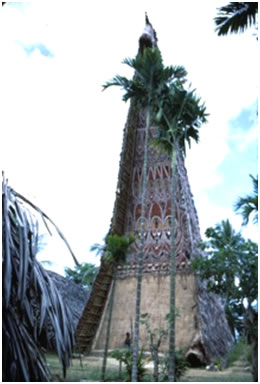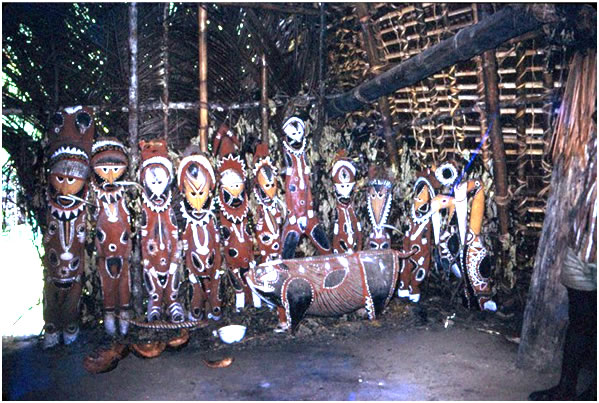
PNGAA Library
Brief history of the National Gallery's artefact collection: Roger Dargie

I read with pleasure the article by Florence Cohen in Una Voce No. 4 December 2010 about the Rabaul Art Society in which she mentioned my late father, Sir William Dargie, who judged the Art Show in 1969. I spent three years in Rabaul between 1969 and 1972 as a kiap.
In June 1970 my father was back in Rabaul, staying with me in Vesters Street. On the morning of the Queen's Birthday holiday in June that year my father was named on 9RB Rabaul 7.45am news as one who had received the honour of a Knighthood by the Queen. Not long after the radio announcement I was rather surprised to see District Commissioner Harry West arrive at my house to be the first to congratulate my father. My father had a long standing interest in PNG, held since his days as a War Artist during the Second World War. He became a member of the Commonwealth Art Advisory Board in 1952 and was appointed chairman of the CAAB in the 1960s.
The Commonwealth Art Advisory Board's responsibilities included the development of art collection policies for the National Gallery, Canberra. It was recommended in the 1966 Lindsay Report (commissioned by Prime Minister Sir Robert Menzies from Sir Daryl Lindsay) that "emphasised that the new National Gallery should focus on the region by building strong collections of works of art from South and South-East Asia and the Pacific". The report added "there is no art gallery in the country with responsibility of acquiring works of art representing the high cultural achievement of Australia's neighbours in southern and eastern Asia and the Pacific Islands." My father, then as Chairman of the CAAB, embarked upon three collecting expeditions to PNG, the first in early 1969, again later that year, and the third trip in early 1970.
I read with some amusement and admiration my father’s official diary of his activities. Compared to my own Patrol Officer’s Field Officer's Journal, I'd have to say that he put me to shame with openly expressed comments on people he met on his daily escapades in the Sepik and to Tami Island. Here is an extract of some of what he wrote:
2/2/69 6AM WITH ADC R HIL AT FINSCHAFEN, he felt I had little chance of getting old items. Went to MALASIGA village, now inhabited by descendants of the carvers of Tami Is. as it is well known they carve for the tourist and curio trade. After many hours and much talk I purchased the following items, nearly all of them very old and beautifully carved in the original Tami style. The two or three more modern pieces I felt I had to purchase because this is one of the necessary preliminaries to induce the people to bring out their old items; all the same the recent carvings are good and craftsmanlike and could be exhibited.
At Malasiga he collected about 10 Tami Island carvings including:
Very large carved wooden bowl sold by Reuben Yabim and carved by Kalek about 1900. This is a splendid museum piece and was one of Reuben's family heirlooms. He is a handsome dignified old man, with a natural courtesy that would put many white men in the territory to shame. He told me he gave up this piece because he realised I had travelled a long way from a far country and for no personal gain, and that he was glad to think that his forefathers and their art would be remembered in the big Haus Tambaran in Canberra. Quite a speech by a natural orator and very touching. I felt almost ashamed to accept the bowl. I have promised to write to him from Canberra and this I must not forget to do.
10/2/69 To DC's office 8am conference with DC (Hicks) and ADCs Faulding and Corrigan re Maprik-Sepik tour. Chartered Catholic mission plane to Maprik. Drew $1000 for tour.
10am to Catholic Mission to inspect their collected artefacts. Indicated to DC Hicks an orators chair ready to be packed for shipment to a buyer in US, which was so high quality that it should not be allowed to leave the T or Aus. He told the Fr in charge of artefacts that he would not sign a permit for its export. Fr looked philosophically resigned and said he had already feared as much.
11am took off in single engine Cessna. Plane with only one tank of petrol and pilot with marked symptoms of death wish. Resolved to fly in no more mission planes.
12 nn Maprik met by ADC Mike Cockburn. By 4WD to Kalabu No 1 village and inspected Haus Tambaran (3) and carved and painted figures inside. Then on up steep and slippery hills to Kalaby No 2 village where I negotiated to buy some carved and painted figures if they could be got out to a truckable road by tomorrow afternoon.
12/2/69 Dep Maprik for Pagwi. Left $200 with ADC Cockburn to pay possible costs of collection from Kuminubus.
During my visit to Kalabu yesterday I completed arrangements for Waiu and Gunjel to paint and carve a whole front of a 60’ HT, everything to be in the old style and with the colours. There is hardly any need for this stipulation because the old way of doing things is alive as long as the carvers and painters like Wainn and Gunjel are alive and the Guando is still sacred in the perpetual darkness of the HT (haus tambaran).
The cost of this completed façade cannot be known until the work is finished. It should not be excessive.
Of course the diary goes on for many pages: the above is typical of most of my father's daily entries. In making his three collection trips to PNG, he managed to collect over 200 pieces including some very significant artefacts from the Sepik and Tami Island area. He also purchased from local dealers, but to my mind the most significant acquisition was a complete collection of spirit figures and the entire façade from a haus tambaran belonging to the Ambelam people of Kuminibus village of East Sepik Province. The façade is the largest piece in the National Gallery's collection. The Gallery has subsequently acquired artefacts from a number of significant sources and now has over 2000 works in the Pacific Arts collection.
In 2008, after nearly forty years in storage in Canberra, part of the collection came to the light of day when the National Gallery held the exhibition, "Gods, Ghosts and Men". Seventy-seven works were exhibited, including the carved spirit figures from the Kuminibus Haus Tambaran. Thanks to Mike and Margaret Cockburn their photograph of the spirit figures as found in the haus tambaran enabled the Gallery to make a most dramatic display of the carvings for the exhibit.
This was an exhibition that emphasised that the art of the Pacific is simply not artefacts created and used for spiritual and other utilitarian use, but works of art in their own right, created by highly skilled artisans and artists.
There were many other kiaps who assisted my father in his work and travels; for those who were not always mentioned in his diary, a belated thanks.
Kuminibus Haus Tambaran and the carved spirit figures (below). Photos courtesy Mike Cockburn |

